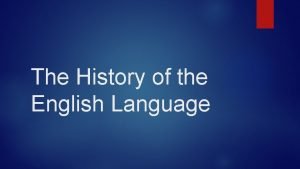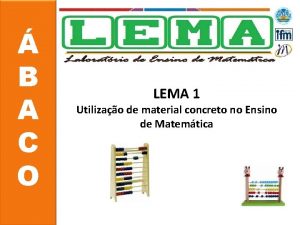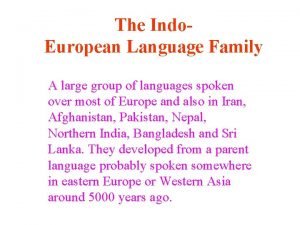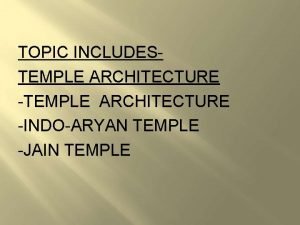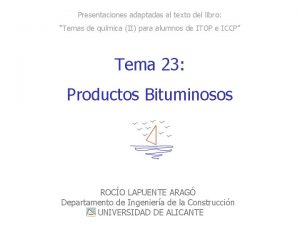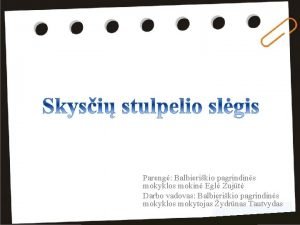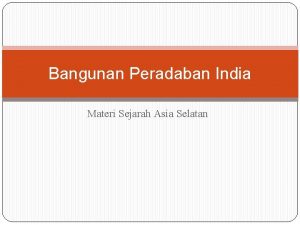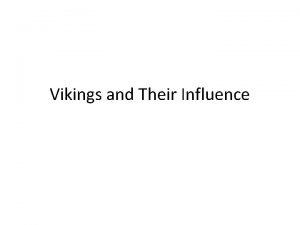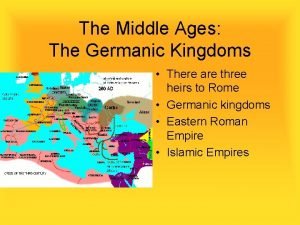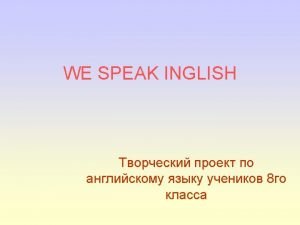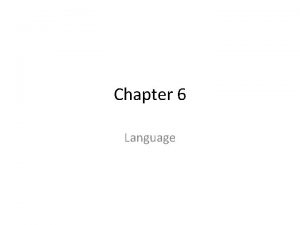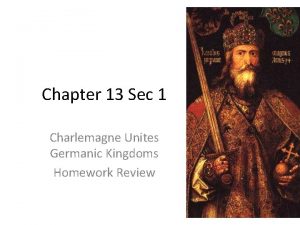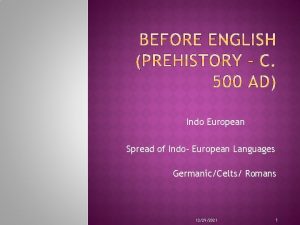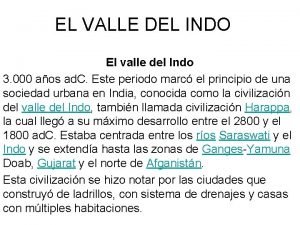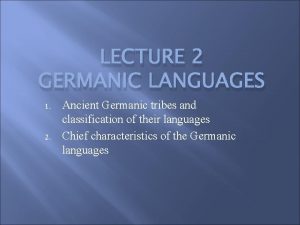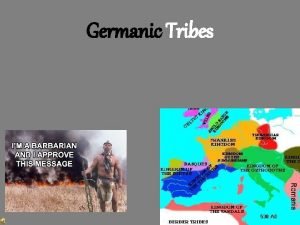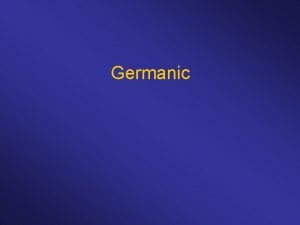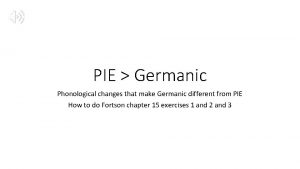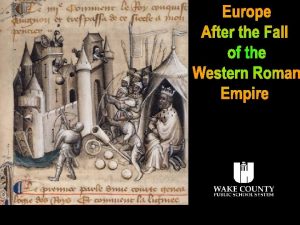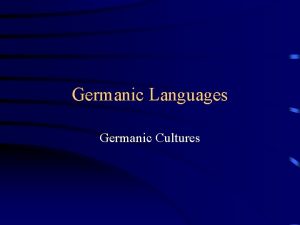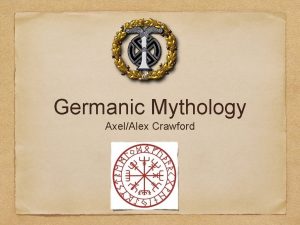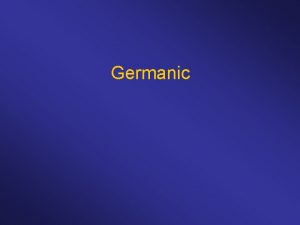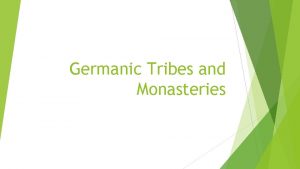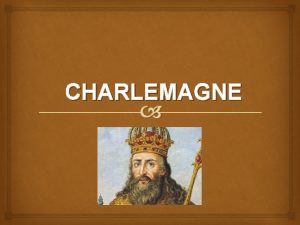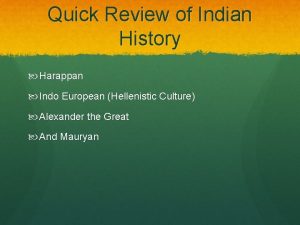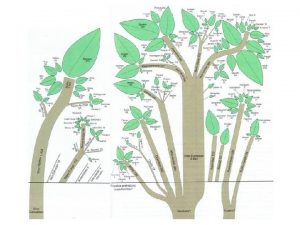Review Germanic is one of the Indo European























- Slides: 23

Review: Germanic is one of the Indo -European family of languages

Main characteristics of Germanic which distinguish it from IE 1. 2. 3. 4. 5. The First Germanic Consonant Shift Vowel gradation Nominal reduction to a 4 -case system Verbal reduction to a 2 -tense system Innovation: weak & strong declensions of adjectives 6. Innovation: weak verbs with "dental" past suffix 7. Stress fixed on the root 8. A common distinctive vocabulary

Main characteristics of Germanic which distinguish it from IE 1. The First Germanic Consonant Shift See 2 nd-week material: • • Indo-European stops at http: //www. hi. is/~peturk/KENNSLA/11/TOPICS/02 IE stops. html The Neo-Grammarians at http: //www. hi. is/~peturk/KENNSLA/11/SLIDES/02 a. N eogrammarians. ppt

First Germanic Consonant Shiftsummary Indo-European Germanic First series p t k kw f þ h hw Second series b d g gw p t k kw Third series bh dh gh ghw b d g gw

Main characteristics of Germanic which distinguish it from IE 1. 2. 3. 4. 5. The First Germanic Consonant Shift Vowel gradation Nominal reduction to a 4 -case system Verbal reduction to a 2 -tense system Innovation: weak & strong declensions of adjectives 6. Innovation: weak verbs with "dental" past suffix 7. Stress fixed on the root 8. A common distinctive vocabulary

2 Vowel gradation • ablaut, hljóðskiptaröð: a set of internal vowel changes expressing different morphological functions. • In IE: e-grade or full grade o-grade zero grade. • Remains today: Mostly strong verbs: ride rode ridden sing sang sung freeze frozen fly flew flown

Main characteristics of Germanic which distinguish it from IE 1. 2. 3. 4. 5. The First Germanic Consonant Shift Vowel gradation Nominal reduction to a 4 -case system Verbal reduction to a 2 -tense system Innovation: weak & strong declensions of adjectives 6. Innovation: weak verbs with "dental" past suffix 7. Stress fixed on the root 8. A common distinctive vocabulary

4 Nominal reduction to a 4 -case system Indo-European • IE had eight cases – nom voc acc gen dat instr abl loc • 3 numbers singular dual plural • 3 genders masculine, feminine neuter Germanic • Germanic 4 cases – nom acc gen dat • Retained 3 numbers in pronouns • 3 genders masculine, feminine neuter

IE nominal cases • • nominative vocative accusative genitive dative instrumental ablative locative

Germanic nominal cases • • nominative vocative accusative genitive dative instrumental ablative locative

Germanic nominal cases • nominative • nefnifall • accusative • þolfall • genitive • eignarfall • dative • þágufall se dæg cymð – sá dagur kemur that day will come ic geman þone dæg - ég man þann dag I remember that day se nama þæs dæges– dagsins nafn the name of the day – the day’s name on þæm dæge – á þeim degi on that day

Seo læfdige geaf þære cwene þæs cyninges hring Frúin gaf drottningunni hring konungsins The lady gave the queen the king’s ring NOMINATIVE subject DATIVE indirect object given to whom? GENITIVE possession ACCUSATIVE direct object what was given

Main characteristics of Germanic which distinguish it from IE 1. 2. 3. 4. 5. The First Germanic Consonant Shift Vowel gradation Nominal reduction to a 4 -case system Verbal reduction to a 2 -tense system Innovation: weak & strong declensions of adjectives 6. Innovation: weak verbs with "dental" past suffix 7. Stress fixed on the root 8. A common distinctive vocabulary

4 Verbs: 2 tenses only • Present it rains, old women are wise non-time specified • Past time orientated Other tenses are periphrastic: it rained, Mary knew the answer it has rained, is raining, will rain, has been raining, etc

Main characteristics of Germanic which distinguish it from IE 1. 2. 3. 4. 5. The First Germanic Consonant Shift Vowel gradation Nominal reduction to a 4 -case system Verbal reduction to a 2 -tense system Innovation: weak & strong declensions of adjectives 6. Innovation: weak verbs with "dental" past suffix 7. Stress fixed on the root 8. A common distinctive vocabulary

5 Innovation: weak & strong declensions of adjectives • ein guter Mann – der gute Mann • góður maður – góði maðurinn • án gód man – se góda man See more on: http: //www. hi. is/~peturk/KENNSLA/11/TOPICS/04 Weak. Strong. Adj. htm

Main characteristics of Germanic which distinguish it from IE 1. 2. 3. 4. 5. The First Germanic Consonant Shift Vowel gradation Nominal reduction to a 4 -case system Verbal reduction to a 2 -tense system Innovation: weak & strong declensions of adjectives 6. Innovation: weak verbs with "dental" past suffix 7. Stress fixed on the root 8. A common distinctive vocabulary

6 Innovation: weak verbs with "dental" past suffix • "weak" = regular verbs (baked) • "strong" = irregular verbs (sing sang sung) • development of a weak class of verbs with dental suffix (d/t) in past tense • heard, baked • höre, hörte, (backe buk) • heyra heyrði, bakaði

Main characteristics of Germanic which distinguish it from IE 1. 2. 3. 4. 5. The First Germanic Consonant Shift Vowel gradation Nominal reduction to a 4 -case system Verbal reduction to a 2 -tense system Innovation: weak & strong declensions of adjectives 6. Innovation: weak verbs with "dental" past suffix 7. Stress fixed on the root 8. A common distinctive vocabulary

7 Stress fixed on the root • pitar • bhratar • fæder • bróðor weakening of endings: hringas > ringes > rings > lufian > lufien > luve > we lufodon > we lufeden > we luvede >

Vowel weakening – further Table base on Strang, p. 415 SINGULAR IE Gmc Go Ice OE Mod. E nominative dhogos ðagas gads dagr dæg day accusative dhoghom ðagan dag dæg day genitive dhogheso ðagesa dagis dags dæges day’s dative dhogoai ðagai daga degi dæge day nominative dhogoes ðagoz dagos dagar dagas days accusative dhogoms ðaganz dagans dagas days genitive dhogeom ðagon dage daga days dative dhoghomos ðagomoz dagam dögum days PLURAL

Main characteristics of Germanic which distinguish it from IE 1. 2. 3. 4. 5. The First Germanic Consonant Shift Vowel gradation Nominal reduction to a 4 -case system Verbal reduction to a 2 -tense system Innovation: weak & strong declensions of adjectives 6. Innovation: weak verbs with "dental" past suffix 7. Stress fixed on the root 8. A common distinctive vocabulary

8 A common distinctive vocabulary Examples of words only found in Germanic: busk- > bush dreug- > drýge > dry, drought tap- > top, tap, tip (typpi) wepnam > wæpen, vopn, weapon Found in Germanic and Celtic: brák- > OE bróc, plural bréc > breeches Ice. brók
 What languages come from latin
What languages come from latin Language
Language Characteristics of indo european languages
Characteristics of indo european languages Ap human geography chapter 5 frq
Ap human geography chapter 5 frq Indo burma region
Indo burma region Indo us science and technology forum
Indo us science and technology forum Indo asia leisure services ltd
Indo asia leisure services ltd Spanish mackerel pacific
Spanish mackerel pacific Número indo-arábico
Número indo-arábico Indo iranian languages
Indo iranian languages Indo-europeans definition
Indo-europeans definition Indigenous aryans
Indigenous aryans Vimal vasahi temple plan
Vimal vasahi temple plan Ductilidad
Ductilidad Indo aryan
Indo aryan Nuo ko priklauso skysčio slėgis į indo dugną?
Nuo ko priklauso skysčio slėgis į indo dugną? Indo arya dan dravida
Indo arya dan dravida Are scandinavians germanic
Are scandinavians germanic Germanic kingdoms in the middle ages
Germanic kingdoms in the middle ages Language
Language Germanic romance slavic
Germanic romance slavic Language
Language Charlemagne unites germanic kingdoms
Charlemagne unites germanic kingdoms Charlemagne accomplishments
Charlemagne accomplishments


